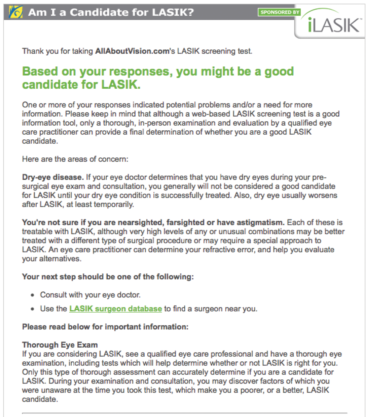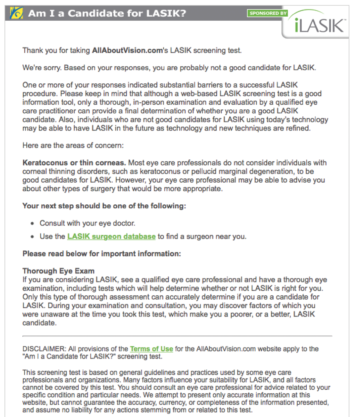
Laser eye surgery is the most well-known and most commonly performed mode of refractive surgery, accounting for approximately 70% of the surgical volume at our Smile Eyes center in Munich, Germany.1 Laser vision correction has been widely marketed globally for the past 2 decades, and the general public is familiar with the term and the concept.
Less well known to the public is lens-based refractive surgery, which includes refractive lens exchange and phakic IOL implantation. At our clinic, these procedures make up 20% and 10% of our refractive surgical volume, respectively.1 Even though lens-based procedures have been around as long as LASIK, if not longer, they have not caught on in the popular consciousness as well as LASIK has—perhaps because they lack the high-tech zest of being performed with a laser.
Nevertheless, some patients who come to us for refractive surgery are better candidates for a lens-based procedure than for LASIK. When I see such patients, therefore, I am faced with the task of educating them about the rationale for implanting an extra lens in their eyes. Patients have many questions. What is this procedure I’ve never heard of? Why is it done? Why are you recommending it for me, instead of the familiar procedure I have seen advertised for so many years? This article details the information I give to patients regarding phakic IOLs, the questions they most often ask, and the answers I give them. My answers are then compared with the answers that patients are likely to find on the first page of a Google search of that same question.
TWO PRINCIPLES
When I believe that a patient is a good candidate for phakic IOLs, I begin by explaining that there are two basic principles for how to correct refractive error:
Principle No. 1: To take something away from the eye. In other words, tissue removal, which is what happens in laser surgery.
Principle No. 2: To add something to the eye. This is what happens in phakic IOL surgery.
This makes it clear to the patient that there are two different ways to solve the problem of refractive error. Often, patients express some disappointment when we start talking about lens surgery because many of them have laser surgery on their minds. When they learn that they are not good candidates for laser vision correction, this can be a bit of a negative experience. If you open the discussion as just described, however, you can turn it into something positive: We are adding to your eye, rather than taking away. This makes the concept and basic principle of the phakic IOL clear at the outset.
I further explain that one of the reasons they are candidates for phakic IOLs is that their amount of myopic refractive error is relatively high. If we were operating under principle No. 1, we would be removing a lot of tissue, and, if we remove too much tissue, there will be nothing left to guarantee the stability of the eye. This explains the logic behind the choice of this procedure: You can only remove tissue to a certain extent, and then you have to choose another approach. That other approach is the use of phakic IOLs.
SETTING EXPECTATIONS
Once I explain those basic concepts, then I introduce and describe the phakic IOL procedure. I tell patients what is involved in the surgery and what they can expect during the experience. Rather than emphasizing the differences between laser and lens surgery, I try to emphasize the similarities:
• Both procedures take about the same amount of time to perform, about 10 minutes;
• Both procedures are done in the outpatient setting; and
• Both are done under local anesthesia.
When I emphasize the common points, patients realize that the differences are not so great as they might have expected.
Whatever the surgery under discussion, whether laser or lens, I always start by showing patients an eye model. I explain the anatomy and show them where the lens, the cornea, and the iris are. Then I show an animated film illustrating the basic principles and the steps of the procedure. I also give patients a brochure from the IOL company to read through.
We use a standardized form for informed consent, as required by our national health insurance. In addition to the form, however, I talk to patients and tell them verbally the things they really need to know about the risks of surgery. Phakic IOL implantation is intraocular surgery, which involves other risks than those attributed to external laser eye surgery.
I also explain that further vision changes can take place after phakic IOL implantation. Cataracts can develop, and this will probably necessitate explantation of the phakic IOL, removal of the cataract, and implantation of a pseudophakic IOL. This is an important issue and must be made clear, although the development of cataract seems to be quite low with the latest EVO Visian ICL model (STAAR Surgical). I also note that refractive surprise can occur, and this may necessitate exchange of the phakic IOL for a different lens power. Presbyopia is also described, so that patients are prepared for the gradual loss of reading vision in their 40s.
The last point I try to emphasize during informed consent is that patients may perceive some glare and halos, especially in the early postoperative period. This will generally get better, but some issues can remain.
Question No. 1: Can I become blind from this surgery?
Dr. Bechmann: Implantation of a phakic IOL is a surgical procedure, and therefore there is always a risk. But with this particular type of surgery, the risk of blindness is almost nonexistent. Cataract can develop, but we can address that. There is also a risk of endophthalmitis infection, but, again, this is low, with only very few cases in the literature of endophthalmitis after phakic IOL surgery. I cannot say with 100% certainty that you will not become blind after surgery, but the risk is extremely low.
Google hit No. 6, an exerpt from a sample informed consent for phakic IOL surgery:
1. In most cases, the surgery will be accomplished with numbing drops, but in some cases the eye surgeon may elect to use an injection around the eye for anesthesia. Very rare complications from injections include damage to the eye muscles, perforation of the eye, and damage to the retina or optic nerve leading to loss of vision.
2. I understand that mild or severe infection is possible. Mild infection can usually be treated with antibiotics and usually does not lead to permanent visual loss. Severe infection, even if treated with antibiotics, could lead to permanent scarring and loss of vision that may require corrective laser surgery or, if very severe, corneal transplantation, blindness, or even loss of the eye.
3. I understand that I could experience damage to the iris (the colored portion of the eye) or develop a rise in the pressure in the front of my eye (secondary glaucoma). I may require another iridotomy or eye drops to control the pressure if this occurs.
4. I understand that I could develop a retinal detachment, a separation of the retina from the inside wall of the eye, which usually results from a tear in the retina and could lead to vision loss. Patients with moderate to high levels of nearsightedness have a higher risk of retinal detachment when compared to the general population. This risk level may be increased with implantation of the phakic IOL.
5. I understand that I may develop a cataract, or a clouding of the eye’s natural lens, which impairs normal vision, and may require removal of the lens, the phakic implant, and insertion of an artificial lens. Patients with high levels of nearsightedness are at higher risk for cataract development, and that risk may be increased with implantation of the phakic IOL.
6. I understand that I may develop corneal swelling (edema) and/or ongoing loss of cells lining the inner surface of my cornea (endothelial cells). These cells play a role in keeping the cornea healthy and clear. Corneal edema and loss of endothelial cells may result in a hazy and opaque appearance of the cornea, which could reduce vision. It is not yet known how much endothelial cell loss will occur and what effect the cell loss and phakic implant will have on the long-term health of the cornea. If too many cells are lost over time, I may need a corneal transplant.
7. I understand that I may develop glaucoma, which is an increase in the pressure of the eye caused by slowed fluid drainage. Glaucoma can lead to vision loss and may require treatment with long-term medications or surgery. Patients with high levels of nearsightedness are at an increased risk for the development of glaucoma, and that risk may be increased by implantation of the lens. The effect of the [phakic IOL] on the future risk of glaucoma is not known.
8. I understand that other complications could threaten my vision, including, but not limited to, iritis or inflammation of the iris (immediate and persistent), uveitis, bleeding, swelling in the retina (macular edema), and other visual complications. Though rare, certain complications may result in total loss of vision or even loss of the eye. Complications may develop days, weeks, months, or even years later.1
1. https://www.aao.org/assets/9a95274a.../phakic-iol-implant-surgery-verisyse-docx
Question No. 2: Why am I not suitable for laser surgery?
Dr. Bechmann: (Many patients come to the practice with laser in mind. They have researched laser surgery, and they want laser surgery. If not, they want a perfect explanation why they cannot have it. In my opening remarks to patients, I already explained the two principles for correction: removal and addition. If patients still have questions, I explain this once more, then I add the following comments.) During the 15 years I have been performing refractive surgery, the cutoff for myopic LASIK has gotten lower and the indications for phakic IOL surgery have increased. This is not because lens surgery is best, it is simply because lens surgery is better in certain circumstances. It is better than LASIK for patients with your degree of refractive error. Over time, we have learned the limitations of laser surgery, and we have learned that lens surgery can do the job beyond those limits.



Google hit No. 4: Are You a Candidate for LASIK? Take this 2-minute screening test and generate your own custom report. LASIK can be very successful when performed on the right patients, but it is not for everyone. This test can help you determine if you’re a good candidate. Here’s how it works:
• Answer 10 to 12 questions about your eyes and health.
• A personalized report is generated in your browser window.
• It’s completely anonymous and no contact information is required.
• By proceeding, you agree to the terms stated below.
TERMS: This screening test is based on general guidelines and practices. You should consult an eye care professional for advice related to your specific condition and particular needs. This test does not constitute medical advice, and AllAboutVision.com does not warrant the accuracy of information presented.1
1. http://www.allaboutvision.com/visionsurgery/am-i-a-lasik-candidate.htm
Question No. 3: What do I have to do for lens maintenance?
Dr. Bechmann: The phakic IOL used in our state is the EVO Visian ICL [STAAR Surgical], which in the past has been known as the Implantable Contact Lens. Although the name sounds like it is a contact lens, this is definitely not the case. There is no lens maintenance because the phakic IOLs will stay inside the eye, as long as there is no cataract development or other reason to remove them.
Google hit No. 1: Implantable contact lenses [ICLs], also known as phakic IOLs, correct vision in much the same way that external contact lenses do, except ICLs are surgically placed inside the eye, where they permanently improve vision. Phakic, from the Greek word “phakos,” for lens, refers to artificial lenses that operate in conjunction with the patient’s natural lenses.
While ICLs function in almost exactly the same way as contact lenses that sit atop the eye, they are also similar to IOLs, which are used during cataract surgery to replace the eye’s natural lens after it has been fragmented and removed. However, during ICL surgery, the natural lens is kept in the eye and works with the implanted lens to correct vision. ICLs are inserted through tiny incisions in the cornea and placed behind or in front of the iris (the colored part of the eye) and in front of the natural lens. These thin, pliable lenses can serve as an alternative to laser eye surgery procedures such as LASIK and are often used to correct conditions that laser procedures may be unable to correct, such as extreme myopia.1
1. http://www.docshop.com/education/vision/refractive/icl
Question No. 4: What happens if my refractive error changes again?
Dr. Bechmann: If your refractive error changes, there are basically two options: (1) We can exchange the phakic IOL for another model with a different lens power, or (2) the laser can easily address most residual errors. At our clinic, enhancement for up to 5 years postoperative is included in the original price. After 5 years, we charge an additional €500 for an enhancement.
Google hit No. 9: If your vision changes dramatically after receiving the implant, your ophthalmologist can remove and replace it. If necessary, another procedure can be performed at any time.
Patients can wear glasses or contact lenses as needed following treatment with [a phakic IOL]. The implant does not treat presbyopia (difficulty with reading in people 40 years of age and older), so some patients may need reading glasses.1
1. http://www.umkelloggeye.org/conditions-treatments/refractive-surgery/phakic-intraocular-lenses-iols
Question No. 5: When can I get back to work?
Dr. Bechmann: We usually do bilateral IOL implantation on consecutive days. Therefore, I recommend that you take the entire week of surgery off from work, and we will schedule the surgery in the beginning of the week. You should focus on having a quiet recovery period, during which work, strenuous activities, and sports should be avoided. After that, you should be fine to resume your normal activities. I also advise using no makeup during that week.
Google hit No. 9: The operation can be performed under either local or general anaesthetic as a day case procedure (you do not need to stay in hospital overnight). You can normally see quite well within 2 days of the surgery. The eyes are operated on 1 week apart. After care is simple: drops 4 times per day for 1 month. Surgery is normally performed on a Friday evening and a return to most types of work is usually possible by the following Monday.1
1. http://www.allan.vu/procedures/icl-implantation/
CONCLUSION
As noted, patients are not as familiar with phakic IOLs as they are with LASIK. Therefore, it is natural for patients to have a lot of questions about the technology and the procedure. It is important for the surgeon and the staff to open the discussion of phakic IOLs in a positive light, so that patients can fully embrace the potential of this procedure for the correction of refractive error.
1. Bechmann M. Lens or Lens Plus Laser. Supplement to CRST Europe. 2017(3):S8-10.



